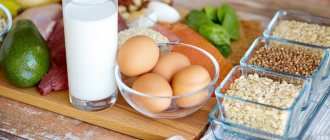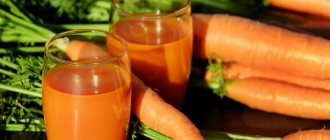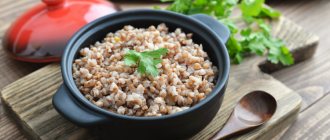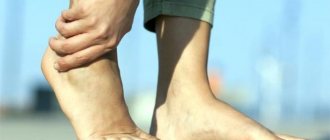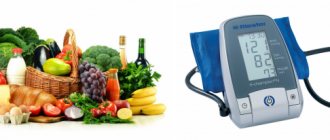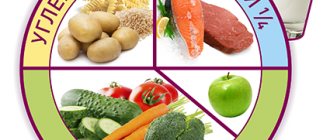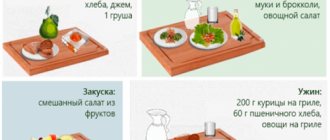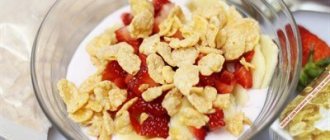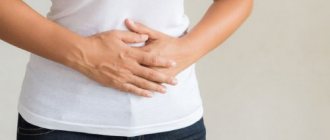Colitis is an inflammatory disease of the colon. Treatment of colitis is always complex. A prerequisite for successful treatment is adherence to a diet.
If you have
chronic colitis
, you should
undergo regular preventive treatment
.
General rules. Duration of the diet.
Nutrition for colitis should be balanced in nutrients. The main goal of the diet is to reduce the load on the entire digestive tract.
- General rules of nutrition for intestinal colitis:
- Fractional meals. 5-6 times a day.
- Give preference to pureed and semi-liquid foods.
- Food should not be hot or cold. The optimal food temperature is 30-40 C
- Elimination of foods containing fiber
- Reduce salt intake to 8-10 grams per day
- Maintain a drinking regime (at least 1.5 liters per day)
- Food can be boiled or steamed.
Acute colitis: causes, symptoms, treatment
This form of the disease is caused by staphylococci, streptococci, salmonella and dysentery microorganisms . It also occurs as a result of common infections (influenza, acute respiratory viral infections, acute respiratory infections, measles), allergies or intolerance to certain medications (usually antibiotics). Often, with acute colitis, the stomach and small intestine become inflamed. As a result, according to the “domino principle,” the normal functioning of other organs of the gastrointestinal tract is disrupted. Depending on the nature of the damage to the large intestine, doctors diagnose several types of acute colitis, namely: catarrhal, ulcerative, erosive, and sometimes fibrinous .
The main symptoms include:
- cramping abdominal pain and bloating;
- the presence of mucus and blood in the stool;
- diarrhea (diarrhea).
The disease usually begins suddenly and, as a rule, with a bowel disorder. Patients feel sick and have no appetite . I am tormented by vomiting and constantly thirsty. They complain of general weakness, a sharp deterioration in health and fever . However, vomiting and diarrhea have their advantages: doctors attribute these manifestations to protective reactions. That is, in this way the body tries to get rid of the poisons that have gotten inside.
Symptoms of acute colitis may depend on the location of the inflammation. For example, when the left half of the colon is affected, pain manifests itself most sharply. Before defecation, they usually intensify and radiate to the perineum and sacrum. Stools are very frequent, up to 20 times a day (sometimes more). The stool has an uneven consistency: dense masses “float” in blood or copious mucus. The areas of the descending and sigmoid colon are painful to palpation. This is where rumbling and splashing sounds are detected.
Colitis
This symptomatology can manifest itself over several weeks and, if left untreated, the acute form usually becomes chronic. Such undesirable developments can be prevented with timely assistance.
Thus, treatment of acute colitis includes the following measures :
- drinking plenty of fluids to replenish fluid losses in the body . It is recommended to drink a specially prepared solution that is well absorbed by the intestines: add a teaspoon of salt and seven to eight teaspoons of sugar per liter of warm boiled water. You can drink mineral water and weak tea, but coffee is undesirable because it affects intestinal motility and increases diarrhea. In some severe cases, fluid is administered intravenously.
- therapeutic fasting for one to two days. Then a strict diet is indicated until the symptoms of the disease completely disappear.
- taking activated carbon. Prescribed for the absorption of toxins in the large intestine.
- taking enzyme preparations, enveloping and adsorbent substances.
- physiotherapeutic treatment.
Nutrition for colitis during exacerbation.
During an exacerbation of colitis, diet is very important. The goal of the diet is to stop inflammation in the intestines, restore proper digestion and eliminate the processes of fermentation and putrefaction.
To do this, it is recommended to completely eliminate foods that cause fermentation or rotting. For diarrhea, it is necessary to exclude foods rich in fiber, vegetables and bran. For constipation, on the contrary, you need to strengthen peristalsis and eat a lot of vegetables and cereals.
Dishes should be steamed or boiled. Food must be ground, chopped or pureed. It is better to overcook the porridge or use special porridge for baby food.
Grocery list
If treatment of gastrointestinal diseases using the fourth table according to Pevzner is carried out at home, be sure to have an accurate list of foods allowed and prohibited for this diet.
If some foods and dishes are in doubt, the best option is to consult with your doctor.
Nutrition for chronic colitis.
Outside of exacerbation, following a diet for colitis allows you to avoid exacerbation.
The diet is based on porridge boiled in water and semi-liquid food. You can add butter to the porridge. Soups are prepared on the second broth from lean meat. Vegetables can be added in small quantities, pureed.
You can eat eggs in the form of steamed omelettes, fish cutlets or steamed minced beef.
You can drink weak black and green teas, herbal tea. Coffee is not recommended, but can be replaced with chicory. The daily volume of water consumed should be about 1.5 liters.
Indications for use.
Therapeutic diet No. 4 according to Pevzner is recommended for chronic colitis and enterocolitis during their exacerbation, for acute gasteroenterocolitis in the initial stage of the disease (in this case, the diet is followed after fasting days), for dysentery, typhoid fever, intestinal tuberculosis during the first five to seven days from the onset of the disease.
Nutritional features.
The food is as gentle as possible on the intestines in mechanical, chemical and thermal terms. Food is boiled, steamed, used in puree or mashed form. A split diet is recommended - up to five to six times a day, subject to bed rest. In this case, the food should be warm. The reduction in the energy value of food is achieved mainly due to carbohydrates and fats. The amount of proteins corresponds to the physiological norm for humans. Salt intake should be reduced. The diet excludes solid, cold and hot, as well as spicy foods. The diet should not contain foods that promote fermentation and putrefactive processes in the intestines, difficult to digest foods, foods that stimulate bile secretion, increased work of the pancreas, and can irritate the liver.
Chemical composition and energy value.
Proteins – 100 g (60-70% animals), fats – 70% (40-50 g butter), carbohydrates – 250 (30-50 g sugar), salt – 8-10 g, free liquid – 1.5 l . The calorie content of the diet is 2050 kcal.
| Product table | |
| Authorized Products | Prohibited Products |
| Bread products | |
| Wheat bread made from premium flour, savory cookies, wheat bread crackers, day-old baked goods in limited quantities. | Rye and fresh bread, as well as pastry products, pancakes, pancakes. |
| Milk and dairy products | |
| Mashed cottage cheese, fresh or unleavened, steam soufflé. | Whole milk, kefir, cream, sour cream, cheese. |
| Soups | |
| Soups in low-fat, weak meat, chicken or fish broth with rice, semolina, noodles, meatballs. Slimy soups made from the same broths with butter are also useful. | Soups with strong, fatty broth, milk soups, cold and bean first courses. |
| Meat and meat dishes | |
| Lean meats, beef, veal, chicken, turkey, pureed, minced or boiled in water or steamed. If minced meat is prepared from meat, then instead of bread you can add a little rice to it. The minced meat is passed through a meat grinder with a fine grid two or three times. You can prepare various types of jellied dishes from pureed meat. | Fatty meats, pork, lamb, goose, duck, sausages, ham, smoked meats, canned meat. In addition, the meat should not be stewed or fried. |
| Fish and fish dishes | |
| Low-fat varieties of fish, for example, pike perch, carp, perch. You can cook it in pieces or it can be mashed, chopped, boiled in water or steamed, or aspic. | Fatty fish, salted, smoked, marinated fish, canned fish. |
| Cereals and pasta | |
| Rice, semolina, rolled oats, pureed buckwheat. They can be cooked in water or in low-fat broth, in the form of steam puddings. Steamed vermicelli is also allowed. | Millet, pearl barley and barley cereals, crumbly porridges, legumes, and pasta casseroles. |
| Vegetables | |
| Vegetables can be eaten only in the form of decoctions. | Vegetables in their natural form are completely excluded. |
| Eggs and egg dishes | |
| Soft-boiled eggs, steam omelet, but no more than one egg per day. | Raw, fried, hard-boiled eggs. |
| Fats | |
| Butter in its natural form, which is added to dishes. | All types of oils and fats except butter. |
| Berries and fruits | |
| Applesauce, jelly and veins from the juices of non-acidic berries, black currants, blueberries, dogwoods, quince, bird cherry. | Fresh fruits and berries, dried fruits, compotes. |
| Sweets | |
| Sugar in limited quantities. | Honey, jam. |
| Beverages | |
| Tea (especially green tea infusion), coffee, cocoa in water, juices of non-acidic berries and fruits diluted with water, decoctions of dried berries, rose hips. | Coffee and cocoa with milk, kvass, grape juice, carbonated and cold drinks. |
Types of treatment table No. 4.
Table No. 4 is divided into three types - No. 4a, No. 4b and No. 4c.
Table No. 4a is indicated for colitis, when fermentation processes clearly predominate. In this case, all the rules of the general table No. 4 apply, but foods and dishes rich in carbohydrates are maximally limited, for example, cereals, bread no more than 100 g per day, sugar no more than 20 g per day. At the same time, the protein content increases due to pureed cottage cheese, meat dishes, etc.
Table No. 4b is recommended for chronic colitis when the exacerbation subsides. The same permits and prohibitions on products apply, but the diet should mainly contain yesterday's bread, cereal soups in a weak broth (meat or fish), pureed porridge (except millet), non-acidic sour cream, kefir, yogurt, compotes and jelly from sweet fruits and berries, butter. Salt is allowed in the amount of 8-10 g.
Table No. 4c is indicated for acute intestinal diseases during the recovery period. This diet serves as a transition to a balanced diet. It is also prescribed outside of exacerbation for concomitant diseases of other organs of the digestive system.
Types of diets:
In case of exacerbation of chronic colitis or in acute form of colitis with loose stools (diarrhea), diet No. 4 is recommended. This diet does not recommend foods rich in fiber. All dishes that cause rotting and fermentation are also excluded.
If the disease occurs with constipation, then diet No. 3 is recommended. This diet recommends foods that enhance intestinal motility and are rich in fiber.
In case of chronic colitis without exacerbation, it is necessary to adhere to diet No. 2.
Prevention of colitis
They say that disease is easier to prevent than to treat. Therefore, preventive measures are very important.
Prevention of acute colitis consists of following the norms of proper nutrition and a healthy lifestyle, maintaining hygiene and sanitary rules.
In the prevention of chronic colitis, special attention is paid to the prevention and timely treatment of acute colitis and especially dysentery. A large role in the prevention of diseases of the gastrointestinal tract is played by high-quality nutrition and, accordingly, maintaining the intestinal microflora in a healthy state . Not to mention the good condition of the chewing apparatus and strengthening of the nervous system.
Back to list Previous article Next article
Recipes for dietary dishes for colitis.
Sample daily menu from a diet for intestinal colitis:
Breakfast:
Boiled oatmeal with butter. Apple compote.
Lunch:
Steamed beef cutlet. Blueberry jelly.
Dinner:
Rice soup with chicken meatballs. Boiled sea fish. Herb tea
Afternoon snack:
Low-fat cottage cheese casserole. Apple compote.
Dinner:
Meat casserole. Weak tea.
Before bedtime:
Compote or jelly.
Causes
At the moment, there is no exact data on what can cause spastic colitis, that is, it is unclear what triggers cause this disease. This is due to the fact that in most patients the causes of colitis are often different.
The etiology of spastic colitis identifies neurogenic factors as the main causes of spasms in the intestines. These can be prolonged stress and fears, regularly occurring conflict situations, hormonal imbalances, and overwork. Apparently, this is why spastic colitis is more common in women, since fluctuations in hormonal balance associated with the menstrual cycle have a significant impact on the emotional state.
About 30% of patients who sought help acquired spastic colitis after acute intestinal infections. Among them, the main ones were salmonellosis and dysentery. The disease is often preceded by dysbiosis, which develops as a result of prolonged antibacterial therapy.
Nutritionist comments:
For colitis, therapeutic nutrition is a prerequisite for successful treatment.
A properly selected diet and its adherence can quickly get rid of the unpleasant symptoms of the disease. “The right choice of a sanatorium is a significant step towards maintaining and increasing health. “Gorny” is a resort complex that combines the experience and knowledge of Russian and Soviet balneology. The presence of modern medical equipment and innovative installations, the professionalism of the staff and love for their work will serve as the key to extending longevity,” - the head physician of the sanatorium, Alexander Olegovich Karaulov.
Disease prognosis
The prognosis depends on the stage at which the disease was detected and therapy was prescribed. If a person begins treatment in a timely manner, stable remission can be achieved quickly. Attacks of exacerbations in such situations are stopped quickly, and the opportunity to lead a full life remains.
The doctor draws up a menu for each patient.
If the diagnosis is made late, cancer may develop, and bleeding in the gastrointestinal tract is often observed.
Some patients become disabled. In severe cases, the patient may die.
The development of pathology is influenced by a person’s age, the presence of other diseases, and individual tolerance of the proposed products. The doctor must take these factors into account when creating a menu.
